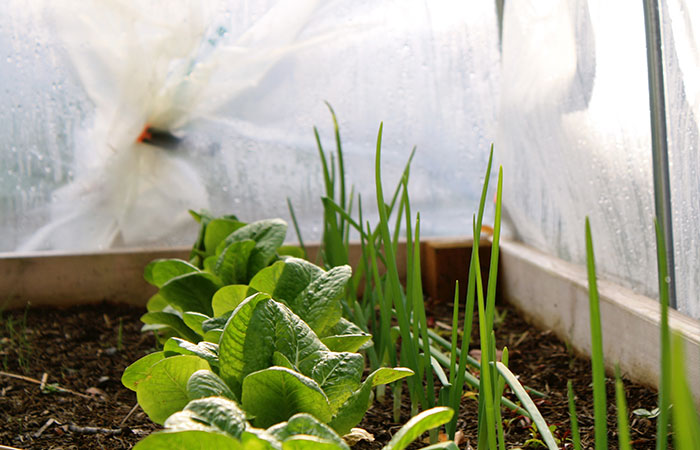Jump Start Your Veggie Garden: Tips for a Chilly Spring
This spring is off to a slow start so far. Between the snow, wind, and hail, what's a vegetable gardener to do?
But despite it all, spring is trying its best to shine through. The songbirds are singing, the geese are returning, and buds and catkins are starting to show on the trees.
All of this means that the days are long enough to support new plant growth. With a little extra care, intrepid veggie gardeners can absolutely get growing now.

What to plant now
Early spring is the prime planting window for peas, hardy greens, cole crops, root vegetables, and perennial edibles. Warm season veggies like tomatoes, corn, and cucumbers are still about two months out, so make sure to leave some space for those too. Of course, you'll want to choose which veggies to grow based on your own tastes, experience level, and available space. Here are a few ideas to get you started.
If you're just getting started with vegetable gardening...
I recommend that you start with snap or snow peas and a few of your favorite greens. This time of year, you can't go wrong with kale and Swiss chard. Spinach, mustard greens, and lettuce are also great choices, but they will appreciate a little extra tender loving care during cold spells.
I always point new gardeners to snap or snow peas because those are the ones you can eat whole, pods and all. Snap peas are the chubby ones that are great in salads. Snow peas are the wide, flat ones that make for excellent stir-fries. Both are also perfect for snacking on right from the vine, and kids tend to love them. Home-grown shelling peas are tasty too, but the extra prep time between harvest and table isn't for everyone.
Don't have the time or space for a pea trellis? No problem. There are excellent, self-supporting dwarf varieties available.
If you're ready to level up...
For those with more experience, or who feel ready for a bit of a challenge, try some of the more elaborate cole crops! Cabbage, broccoli, cauliflower, and kohlrabi are a few delicious examples of plants in the brassica family that produce more than just edible leaves. These take a bit more space in the garden than leafy greens, and getting them to produce can take a little doing, but the rewards are well worth it.
Root vegetables like carrots, beets, and radishes are also great crops to plant this time of year. We carry starts for carrots and beets, but I recommend trying at least some from seeds planted right in the ground. Once they sprout, direct-sown root crops will often be stronger and grow faster than transplanted ones.
Try some potatoes, and perennial edibles too!
It doesn't get more traditional and wholesome than home-grown spuds. Potatoes are a great crop for beginners and seasoned gardeners alike. They make a fun learning opportunity for kids too. The unique thing about potatoes is that the "seeds" are potatoes themselves. Just plop small whole seed potatoes or chunks of larger ones into the ground, and you could harvest up to ten times the amount you planted.
This is also the time to plant perennial edibles like rhubarb, horseradish, asparagus, fruit trees, berries, and herbs. Since perennials are hardy enough to survive our winters, they won't be daunted at all by a little snow. I think even beginning gardeners ought to give strawberries a try. They're low-growing, low-maintenance, and you can't beat fresh strawberries for a summer snack!

Warm up the soil
A little preparation goes a long way. Get your garden beds ready for veggies by letting them dry out and warm up. Veggie starts are a lot like people in that they are more likely to get sick when they're exposed to too much cold and damp.
Covering the soil before planting allows it to dry out, which prevents dirt clods that are difficult to work with. Keeping seedlings covered after you plant will help protect them as they get established. In cold weather, this is essential for tender veggies like lettuce, but even the hardiest veggies will appreciate it.
Anything you can do to insulate the soil and protect it from harsh rains will help. Try covering the soil with a thick layer of fluffy mulch like leaves or straw. When you're ready to plant, simply scoot the mulch to the side around each transplant. Or you could build a simple cloche.
A cloche is basically a miniature, temporary greenhouse that you build right over an existing veggie bed. They're easy to make! You can keep it super simple or get a bit more fancy, but I personally like this extra-easy method: Make a hoop-shaped frame across your bed by jabbing one end of a PVC pipe into the ground, bending the pipe over to form an arch, then jabbing the other end in on the opposite side. I usually use 3-4 pieces of pipe down the length of a bed. Once you have your frame, drape a piece of sturdy, transparent plastic sheeting over the top, stretch it taut, and secure it to the pipes with whatever clips or ties you might have handy.
Garden fabric is just one more tool that can help gardeners get an early start. It's simply woven synthetic cloth that insulates the soil and protect young seedlings from insects, all while letting sunlight and rain through. It can be supported by hoops or just laid directly on top of beds.
Time to get growing!
Ready to earn your place as a truly intrepid Pacific Northwest Gardener? Check out our information library for more tips and general advice on veggie growing. No matter what the weather throws our way, now is the time to grab some hardy veggie starts, your sturdiest rubber boots, and a wheelbarrow full of mulch, and get growing.
